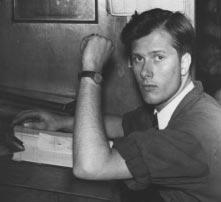
|
Refugee in search of a homeland
to be twisted initially by hand and wound on each spool. When all were connected, the machine was turned on and the spools began to turn rapidly, adding the yarn on to the spool. When a bobbin ran out of wool, it had to be replaced by hand with a full bobbin. It took quite some skill to join the sliver in such a way that it wouldn't show in the yarn, and the women working there were all experts in their field.

|
I at Dahlhausen (mixing tops)
When that was done, the yarn was twisted and twined, to make for instance 4-ply or 8-ply knitting wool. The yarn was then wound on wheel like bobbins. These were put into a conditioner, before the wool was taken off the bobbins and twisted into skeins and a paper wrapper went around each skein with the label "Ilse Wolle".
I found the whole manufacturing process most interesting. The women had to be meticulously clean, as any fluff flying around would contaminate the yarn and render it faulty. The humidity in the factory had to be kept fairly high at all time, to avoid static electricity forming. This made working conditions sometimes quite unpleasant for the workers, but they never grumbled. The pay was good and they were treated well by the management.
Hardt Pocorny & Co specialised in the manufacture of knitting wools only. A factory in the neighbouring village Dahlerau, the firm of Johann Wülfing & Sohn, had a worsted spinning mill, producing a finer yarn for weaving. This also belonged to the family, and I was given the opportunity to go through the processing of that firm for four weeks. The yarn they manufactured was for their weaving mill in Remscheid-Lennep,
237